نجاح!
لقد وقعت مع عميل جديد في وكالتك. والآن أنت مستعد لإظهار سبب اتخاذهم أفضل قرار بالاستثمار في فريقك.
على الرغم من أنك جعلتهم يوقعون على الاتفاقية، إلا أنك لم تنتهِ بعد من كسب هؤلاء العملاء الجدد. بعد الأعمال الورقية، عليك التأكد من أن عملية تأهيل العميل تمضي خطوة أخرى إلى الأمام لغرس الثقة في وكالتك من خلال إظهار كل شيء (وكل خطوة) يمكنهم توقعها.
في الواقع، فإن استطلاع Wyzowl وجد أن 88% من المشاركين في الاستطلاع قالوا إنهم سيكونون أكثر ولاءً للشركة التي تعطي الأولوية للإعداد والمحتوى التعليمي. بينما تستثمر الوكالات ساعات لا حصر لها في مبادرات ما قبل التأهيل، ليس من غير المألوف أن تنقطع هذه المبادرات عند تحويل العميل المحتمل إلى عميل في النهاية.
ستقوم فرق المبيعات بالرد على طلبات تقديم العروض، وتنظيم مقترح مشروع، والإجابة على استبيانات الأمان، والعمل مع الفرق القانونية على التعاقد، لكن البعض سيتوقف عن رعاية العلاقة مع العميل بعد ذلك. ومع ذلك، هناك طريقة أسهل بكثير لمنع هذا الانفصال من خلال توفير تجربة تأهيل كاملة للعميل.
ما هو تأهيل العميل؟
تهيئة العميل هي عملية دمج العملاء الجدد في الأعمال التجارية وإقامة علاقة عمل قوية ومثمرة. إنها خطوة حاسمة في العلاقة بين العميل والشركة لأنها تحدد مسار التفاعلات المستقبلية وتساعد على بناء الثقة والتفاهم المتبادل. تساعد هذه العملية العملاء على معرفة جميع ميزات وفوائد المنتج حتى يحصلوا على القيمة الإجمالية - مما يقلل من فرصة حدوث تخبط.
ما الذي يمكن أن تفعله الوكالات لضمان النجاح على المدى الطويل مع قائمة عملائها؟
كن مستثمراً في تأهيلهم كما تستثمر في توليد العملاء المحتملين. الانطباعات الأولى مهمة. إن عملية التأهيل هي فرصتك لتحديد التوقعات لمنع زحف النطاق، وصياغة تجارب العملاء التي تعزز علامتك التجارية وتخلق تجربة إيجابية للعملاء لزيادة الربحية.
لماذا يعتبر تأهيل العميل مهمًا؟
إن تأهيل العميل هو خطوة حيوية في العلاقة بين العميل والشركة تساعد على ترسيخ التفاهم المتبادل، وتحسين رضا العميل، وزيادة الكفاءة، وتعزيز العلاقة من أجل شراكة ناجحة وطويلة الأمد.
فيما يلي بعض الأسباب الرئيسية لأهمية تأهيل العميل:
- فهم أفضل: يساعد التأهيل على اكتساب فهم أعمق لاحتياجات العميل وتوقعاته وأهدافه. هذه المعلومات ضرورية لضمان أن تكون العلاقة مثمرة وناجحة.
- تحسين رضا العميل: عندما يشعر العملاء بالترحيب والتقدير، فمن المرجح أن يكونوا أكثر رضا عن الخدمات التي يتلقونها ويظلوا مخلصين للشركة. يساعد التأهيل على خلق انطباع أول إيجابي وتعزيز الشعور بالانتماء.
- زيادة الكفاءة: يمكن لعملية التأهيل المنظمة بشكل جيد أن تساعد علىتبسيط العملية دمج العملاء الجدد في العمل، مما يقلل من الارتباك ويقلل من مخاطر الأخطاء.
- علاقات أقوى: يساعد التأهيل على بناء الثقة وتعزيز علاقات قوية وطويلة الأمد بين العملاء والشركات. وهذا بدوره يمكن أن يؤدي إلى زيادة ولاء العملاء وتكرار الأعمال.
عملية تأهيل العملاء المكونة من 7 خطوات
لمساعدتك على تحسين أو توسيع نطاق عملية تأهيل العملاء، قمنا بتجميع سبع خطوات - إلى جانب بعض النماذج المفيدة - من المؤكد أنها ستثير إعجاب عملائك الجدد منذ البداية.
لنبدأ!
1. وضع توقعات واضحة حول وكالتك وما سيتم تسليمه
لقد فعلتها! لقد حان الوقت للاحتفال بتلك الأسابيع أو الأشهر التي قضيتها في بناء علاقة مع عميل محتمل أصبح عميلاً أخيرًا. لقد شعروا هم بذلك، وشعرت أنت بذلك، وهي فرصة جديدة مشرقة ولامعة لتحبب نفسك إليهم.
يجب أن تقوم تجربة التهيئة المناسبة بأمرين:
- أولاً، يجب أن تؤكد لعميلك أنه اتخذ الخيار الصحيح في العمل مع وكالتك.
- ثانيًا، يجب أن تزيل أي شكوك من خلال تحديد ما يمكن أن يتوقعه العميل من العلاقة بوضوح.
الجزء الأول هو الجزء الممتع ويتم عادةً عن طريق إرسال هدية رمزية للعميل الجديد تعبيراً عن تقديرك له. يمكن أن يكون ذلك حزمة من الهدايا ذات العلامات التجارية أو بعض المشروبات الكحولية الفاخرة اعتماداً على الأسلوب الذي تريد وكالتك أن تحدده.
على الرغم من أنها قد تبدو غير ضرورية، إلا أن هذه اللفتات الحسنة ترفع من شأن وكالتك لتظهر كشريك وليس مجرد بائع آخر للعملاء الجدد. كما أن هذه اللمسات الصغيرة تفعل المعجزات لتحسين صافي نقاط المروجين (NPS).
راجع قائمتنا الخاصة بـ
/href/ https://clickup.com/blog/vendor-management-software// أفضل برامج إدارة البائعين* *%/href/_
!
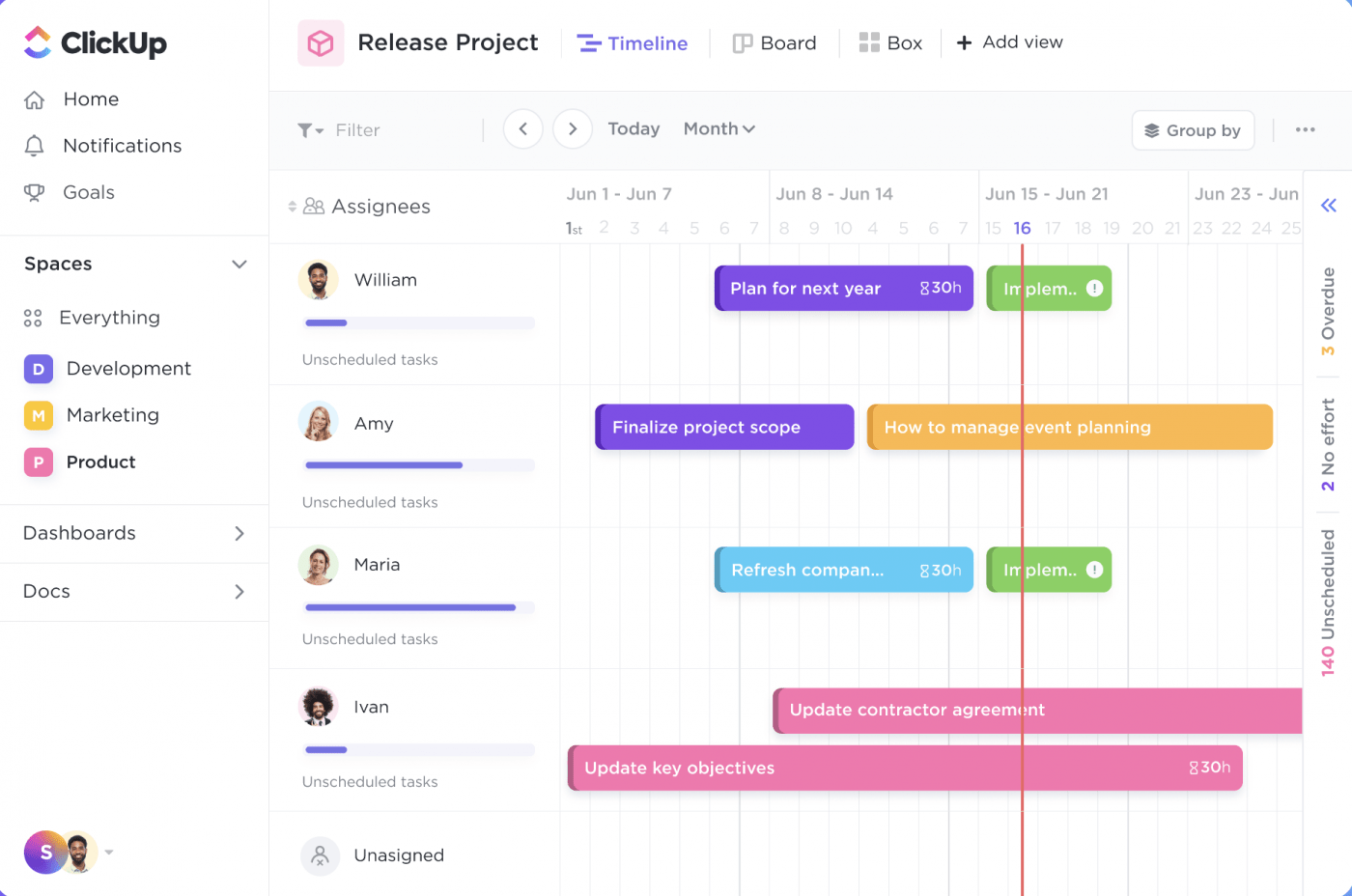
توفر طريقة عرض المخطط الزمني في ClickUp نظرة شاملة لمواردك ومهامك
الجزء الثاني - تحديد التوقعات - من الأفضل أن يتم ذلك في رسالة بريد إلكتروني تعريفية تحدد بوضوح ما يمكن أن يتوقعه العميل منك. يجب أن تحدد عملية تأهيل العميل، وتقدم نقاط الاتصال الخاصة بك، وتتضمن بياناً واضحاً عن الجدول الزمني للخطوات التالية، وتقديم قائمة مراجعة لإعداد العميل.
تطمئن هذه الشفافية عملاءك الجدد بأنهم قاموا باستثمار جيد وتسد الفجوة بين التحويل وعملية التأهيل حتى لا يشعروا بأنهم متروكون في طي النسيان.
نصيحة احترافية استخدم النقر فوق الأتمتة لتتبع مكان تواجد العملاء في عملية التأهيل، احتفل بـ المعالم والحفاظ عليها للمضي قدماً. على سبيل المثال، يجب تمييز فريق عمليات العملاء تلقائيًا عند تغيير حالة العميل المحتمل من "عميل محتمل" إلى "عميل جديد" كتذكير لـ إرسال هدية ترحيبية .
2. تصميم وإرسال استبيان تأهيل العميل وإرساله
من المحتمل أنك قمت بإجراء تقييم أولي للعميل أثناء عملية البيع للتأكد من أن العميل مناسب لك. أما الآن وقد وقع العميل على العقد، فقد حان الوقت للتعمق أكثر في ما يبحث عنه بالضبط. حان وقت استبيان تأهيل العميل.
يعد استبيان التأهيل خطوة حاسمة في عملية تأهيل العميل الجيدة. لا يمكنك حتى تلبية التوقعات (ناهيك عن تجاوزها) دون معرفة ما هي تلك التوقعات وما هي الأصول الموجودة لدى العميل لمساعدتك على تحقيقها. وهذا ما سيساعدك استبيان التأهيل على اكتشافه.

قم بإعداد النماذج بسهولة في ClickUp باستخدام حقول مخصصة لجمع المعلومات التي تحتاجها بالضبط
بمساعدة عرض نموذج ClickUp يمكنك تحويل ردود الاستبيان مباشرةً إلى مهام أو ببساطة جمع المعلومات التي تحتاجها من استبيان العميل. على سبيل المثال، تختلف استبيانات تأهيل العملاء بناءً على المنتج أو الخدمة التي تقدمها، ولكن بعض الأسئلة التي يمكنك تضمينها هي
- ما الهدف (الأهداف) العامة التي تريد تحقيقها من خلال منتجنا/خدمتنا؟
- ما هي مؤشرات الأداء الرئيسية التي تستهدفها خلال الأشهر الستة المقبلة أو خلال عام؟
- كيف تريد تخصيص ميزانيتك؟
- هل لديك أي موارد أو أصول موجودة مسبقًا يمكننا الاستفادة منها لمساعدتك في تحقيق أهدافك؟
- ما هي بعض الأمثلة لـ [أدخل خط الخدمة] التي تفضلها؟
- من من من فريقك سيكون نقطة الاتصال الرئيسية لدينا، ومن هم أصحاب المصلحة الرئيسيين لديك؟
- ما هو ملف تعريف العميل المثالي (ICP)؟
- كيف تأمل أن يساعدك منتجنا/خدمتنا في تحويل عملائك من عملاء إلى عملاء؟
ستساعدك هذه الأسئلة على تحديد كيفية إظهار القيمة بسرعة بناءً على احتياجات العميل وأهدافه المحددة للحصول على أفضل عملية تأهيل للعملاء.
3. إنشاء اتفاقية مستوى الخدمة (SLA)
إذا لم يحدد عقدك الأطراف المسؤولة وتواريخ استحقاق العمل، ففكر في إنشاء اتفاقية مستوى الخدمة. تأخذ اتفاقية مستوى الخدمة كل ما تعلمته من استبيان التأهيل وتطبقه على الشروط المتعاقد عليها لمشاركتك مع العميل.
إذا كان العقد هو "ماذا" الذي يشرح علاقتك المستقبلية، فإن اتفاقية مستوى الخدمة هي "من" و"متى" و"كيف".
على سبيل المثال، فإن ينص العقد على اتفاقية لتوفير استراتيجية تسويق مقابل سعر معين. تحدد اتفاقية مستوى الخدمة كيفية إنشاء تلك الاستراتيجية وتسليمها، بما في ذلك أصحاب المهام والجداول الزمنية والمسؤوليات المحددة لأعضاء الفريق.
هذا يضمن لك ولعملائك التوافق بينك وبين عملائك بشأن التوقعات والمساءلة في حالة عدم سير أي جزء من الاتفاقية كما هو مخطط له في عملية تأهيل العميل.
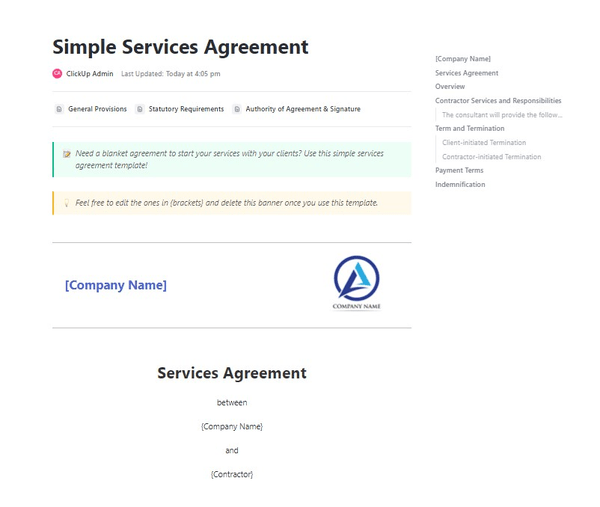
استخدم هذا القالب لاتفاقية شاملة لبدء خدماتك مع عملائك بشكل أسرع قم بتنزيل هذا القالب
4. استضافة اجتماع انطلاق المشروع
A اجتماع الانطلاق يوطد علاقة العمل بينكما. بالتأكيد، ربما تكونا قد قضيتما بعض الوقت في التعرف على بعضكما البعض قبل ذلك، لكن عملية تأهيل العميل هي فرصتكما لتحديد كيفية عملكما معًا. خلال مكالمة تأهيل العميل هذه، يجب عليكما
- التعريف بفريقك
- تحديد الطريقة التي يفضلها الجميع للتواصل والحصول على المنتج أو الخدمة، مثل من خلالسلاك أو البريد الإلكتروني
- إنشاءنطاق المشروع والأهداف (استخدملوحة تحكم ClickUp!)
- الخطوط العريضة لكيفيةسوف تتعاون، بما في ذلك الإيقاع لعمليات التسليم وكيف ستتلقى ملاحظاتك
- تقديم اتفاقية مستوى الخدمة الخاصة بك
- توفير الموارد مثل معلومات الاتصال بفريقكإدارة المشروع الوصول إلى الأداة، وأشياء أخرى يحتاج عميلك الجديد إلى معرفتها
يجب أن تعزز مكالمة الانطلاق التوقعات التي تم تحديدها أثناء عملية التعاقد وإعداد العميل حتى تبدأ بشكل صحيح. وهذا يخلق فرصة لتأكيد توافق كلا الفريقين على الاستراتيجية وأهداف الخدمة قبل البدء في تنفيذ المشاريع.
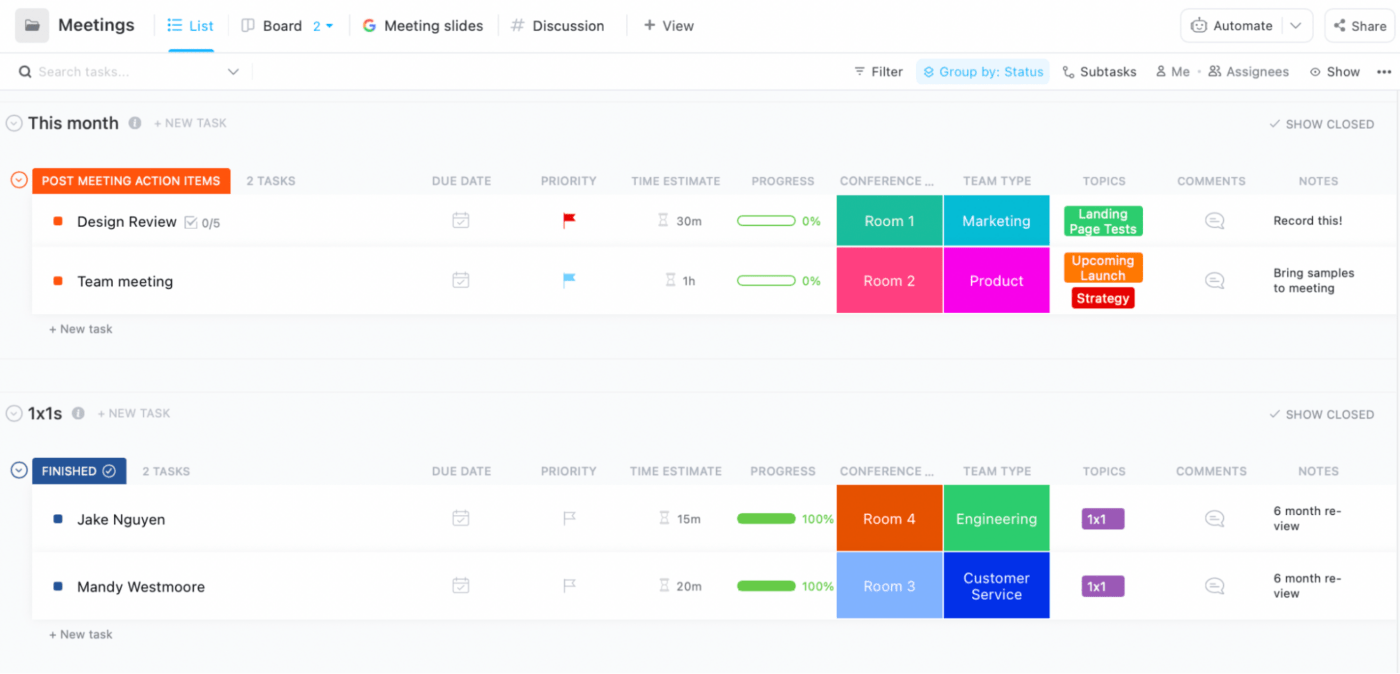
استخدام قالب تعقب الاجتماعات الخاص ب ClickUp لتنظيم اجتماعاتك وتحديد أولوياتها قم بتنزيل هذا النموذج
5. حدد موعدًا لاجتماع داخلي بعد الانطلاق
إن الاجتماع الداخلي لما بعد الانطلاق هو فرصتك لإبراز أي ملاحظات من مكالمة الانطلاق، والعمل على حل العقبات المتوقعة والإجابة على الأسئلة. تمامًا مثل اجتماع ما بعد انطلاق المشروع الذي يعمل على مواءمة فريقك مع فريق عميلك، فإن الاجتماع الداخلي لما بعد انطلاق المشروع يعمل على مواءمة فرقك الداخلية المختلفة في المشروع.
لا يجب أن تكون عملية التهيئة الجيدة مرهقة. وبدلاً من ذلك، استخدم هذا الاجتماع للتعاون على الاستراتيجيات التي ستستفيد من مهارات كل عضو من أعضاء الفريق، واطلع فريقك الداخلي على اتفاقية مستوى الخدمة ونطاق المشروع، وقم بتعيين كل مهمة. يجب أن يحدد هذا الاجتماع التوقعات والأدوار الداخلية حتى تتمكن من تقديم الخدمات للعميل بشكل متسق وفعال.
على سبيل المثال، قم بمراجعة التسليمات التي ستساهم في كل جزء من الاستراتيجية. سيساعدك هذا في عملية التهيئة من خلال تحديد نقطة الاتصال الداخلية للحساب. اسأل أيضًا عما إذا كان هناك أي جزء معين من الاستراتيجية يتحمس له أو يفضله أعضاء فريق معينون.
يجب أن تبدو عملية التأهيل وكأنها جهد مزدوج. يوفر أعضاء الفريق المتوافقون مع مخرجات وتوقعات واضحة أفضل النتائج الممكنة وينقلون هذه الطاقة إلى تجارب إيجابية للعملاء.
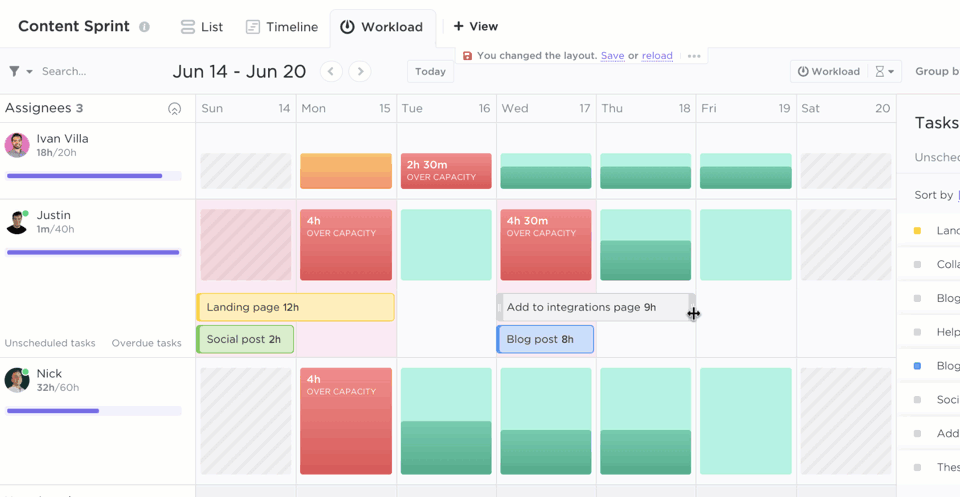
استخدم طريقة عرض عبء العمل في ClickUp لمعرفة من هو متقدم أو متأخر وسحب المهام وإفلاتها بسهولة لإعادة تخصيص الموارد
أسهل طريقة لمواءمة الفرق هي من خلال منصة إنتاجية مركزية، مثل ClickUp. يمكن للفرق التعاون بسهولة في كل جانب من جوانب المشروع - دون الحاجة إلى التنقل بين الأدوات والمنصات.
6. التخطيط لعمليات المتابعة الروتينية
العميل المنتظم الاتصالات هي جزء من العلاقات الصحية والمثمرة خاصة في عملية تأهيل العميل. ومع ذلك، يجب أن تخدم هذه الاتصالات غرضًا واضحًا؛ إما لجعل حياة عميلك أسهل أو لجعل مشروعك أكثر قيمة.
جدولة شهرية منتظمة اجتماعات العملاء كجزء من عملية التهيئة ستساعد فريقك على معالجة أي مخاوف مقدماً أثناء عملكما معاً.
في هذه الاجتماعات، قم بإطلاع العملاء على آخر المستجدات المتعلقة بالاستراتيجية وقدم تقارير عن نتائج الخدمة لتعزيز القيمة التي تقدمها. يساعدك ذلك على البقاء في صدارة اهتمامات عملائك، مما يزيد من الإحالات ويوفر المزيد من الفرص لعمليات البيع، وفي النهاية تحقيق المزيد من الأرباح. إرسال بريد إلكتروني للمتابعة يلخص ما تمت مناقشته و بنود العمل لبناء استراتيجية المحتوى الخاص بك بسرعة من الألف إلى الياء تنزيل هذا القالب بالإضافة إلى الاجتماعات الشهرية، قدم تحديثات أسبوعية مكتوبة عبر Slack أو البريد الإلكتروني أو القناة المفضلة للعميل. يجب أن تتضمن هذه التحديثات ما يلي مخرجات المشروع وأي بنود عمل معلقة من الأسبوع السابق.
على سبيل المثال، قد تقوم شركة تسويق المحتوى بتضمين العناصر التالية في تحديثها الأسبوعي بعد عملية الإعداد الأولية:
- قائمة بـوسائل التواصل الاجتماعي ومنشورات المدونات التي نشرتها للعميل في الأسبوع السابق
- ما المنشورات التي يمكن أن يتوقع العميل تسليمها في الأسبوع الحالي
- الموافقات المعلقة على المحتوى التي تحتاجها من العميل
- بيانات الملكية أو الخبراء المتخصصين الذين تحتاج إلى الوصول إليهم للمشاريع القادمة
توفر هذه التحديثات فرصة للتركيز على أسئلة العميل واستباق أي عوائق محتملة للأسبوع القادم، بالإضافة إلى تعزيز قيمتك.
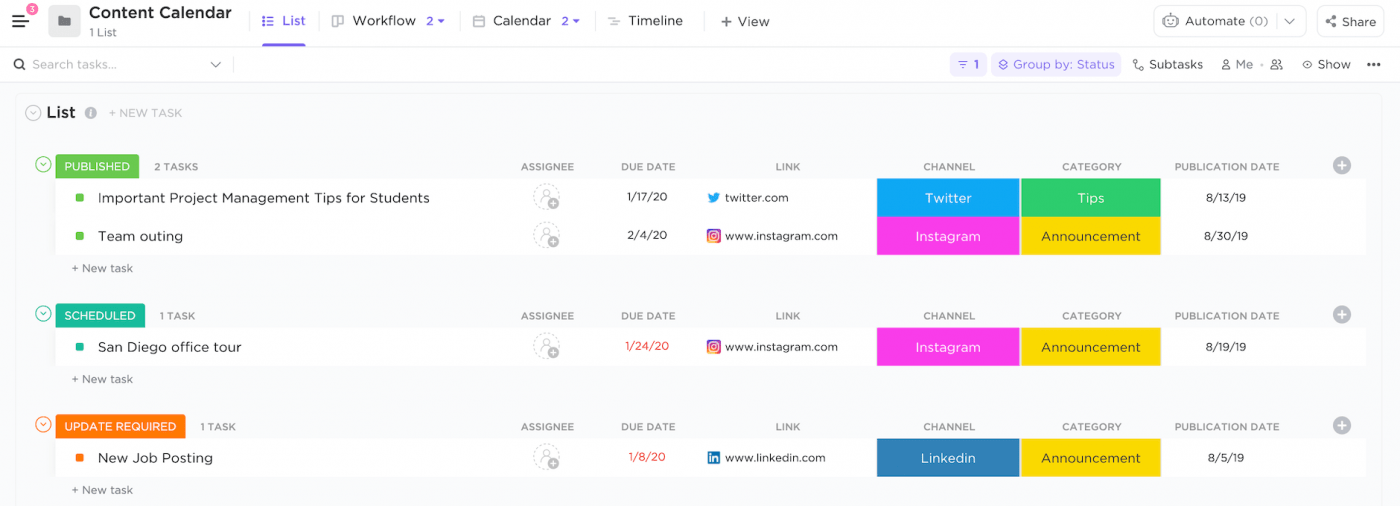
اعرض بسهولة تقويم المحتوى في طريقة عرض الجدول في ClickUp
وإذا كنت بحاجة إلى مزيد من الشفافية والتواصل بين عمليات تسجيل الوصول الأسبوعية والاجتماعات الشهرية، فاستخدم ميزة عرض الجدول في ClickUp لتسجيل تحديثات العميل والاتصال مهام ClickUp لهم
7. تحسين تجربة الإعداد
مع توسع الشركات، توقع حدوث بعض الثغرات في تجربة التأهيل. من الضروري تحديد هذه الثغرات بشكل استباقي وتحسينها وفقًا لذلك. هناك خطوتان لتحسين عملية التأهيل؛ جمع الملاحظات والتعاون داخلياً لمعالجة هذه الملاحظات.
ابدأ بجمع ملاحظات العملاء الجدد بشكل رسمي وغير رسمي. ستسأل عملية تأهيل العميل الناجحة العملاء في كل اجتماع متابعة عما إذا كان لديهم أي أسئلة أو مخاوف وتدوين أنواع الأسئلة التي تظهر بشكل منتظم. اجمع هذه الملاحظات في مساحة تعاونية حيث يمكن لفريقك فرزها وتحليلها في وقت لاحق.
بعد ذلك، اطلب تعليقات مباشرة عن طريق إرسال استبيان تجربة تأهيل العميل الجديد بعد أن يكمل كل عميل عملية التأهيل (عادةً بعد 120 يوماً من التوقيع). مع نماذج ClickUp ، يمكنك بسهولة تحويل الردود على الاستبيان إلى مهام قابلة للتنفيذ ليتابعها فريقك.
سيساعدك هذان الشكلان من الملاحظات على اكتشاف ما يحتاجه عميلك الجديد والأماكن التي لا تلبي احتياجات عملائك الحاليين سير العمل .
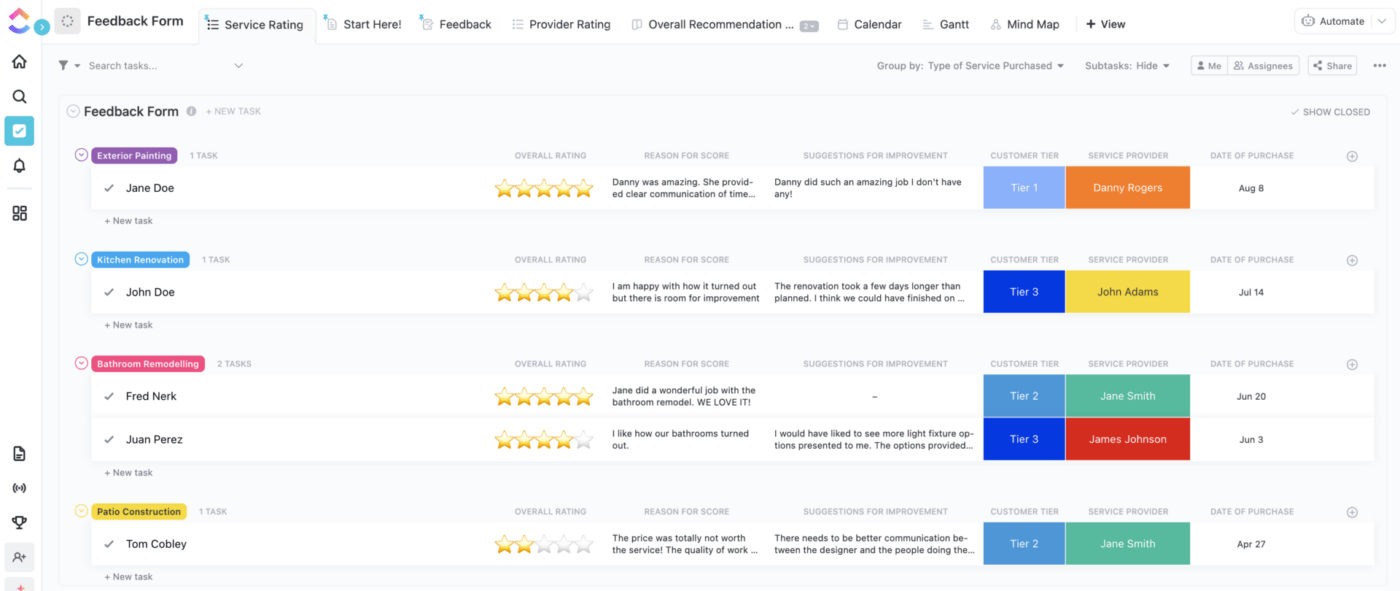
استخدام قالب نموذج نموذج ملاحظات العملاء الخاص ب ClickUp لبدء عملية جمع المعلومات بسرعة تنزيل هذا النموذج
لا تنسى التعاون داخليًا
ستخبرك ملاحظات العملاء بأماكن حدوث الأعطال، ولكن الأمر الآن متروك لفريقك للتوصل إلى حل. أسهل طريقة للقيام بذلك هي جمع ردود الفعل من عملائك الجدد على ClickUp Whiteboard .
اعمل بالتعاون مع فريق الإعداد الداخلي لديك لتجميع الردود وتحديد المواضيع. بمجرد تحديد المواضيع، فكّر في مكان رحلة العميل يمكنك تقديم حلول لهذه الثغرات.
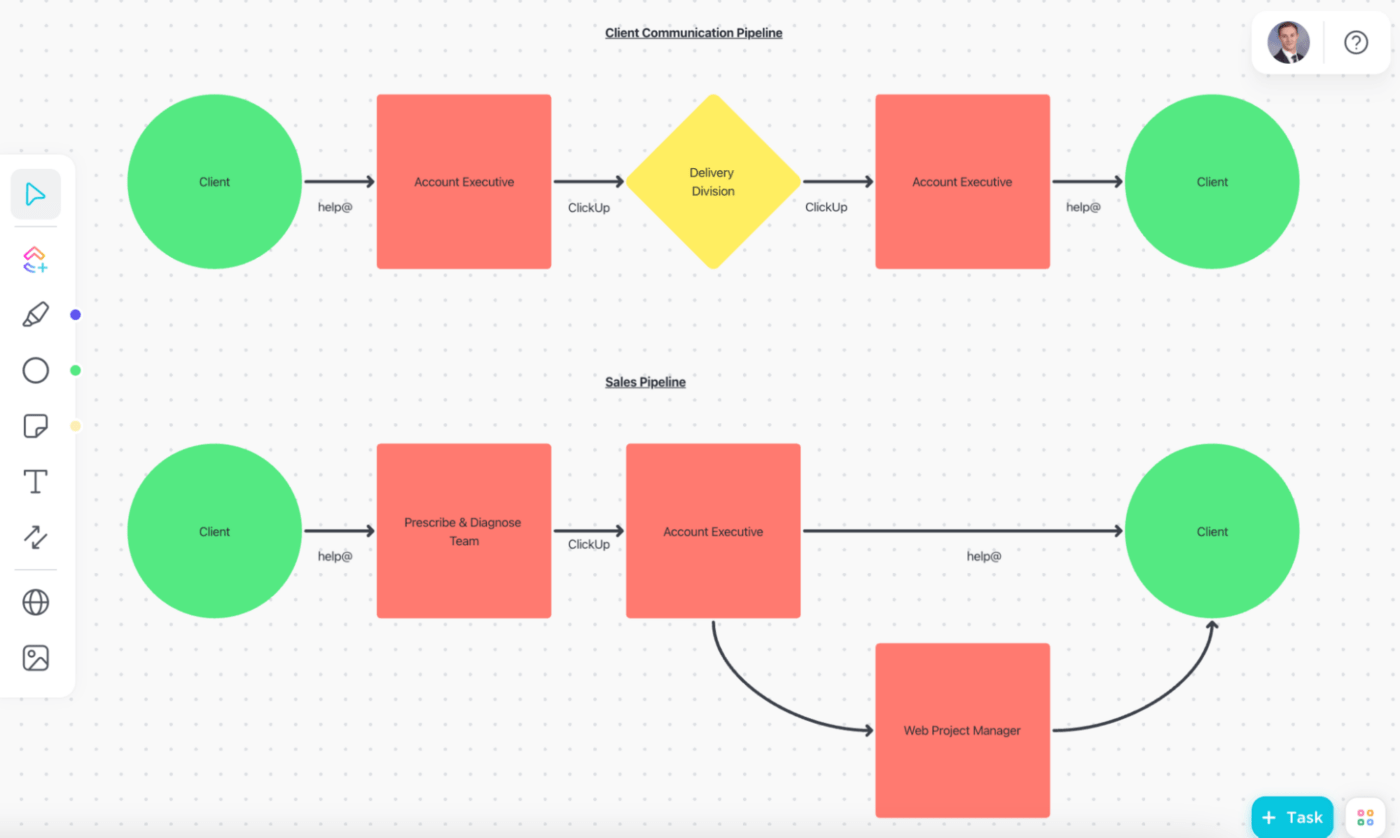
مثال على السبورة البيضاء لمرشد الصيدلة لويس نوروود
لويس نوروود، رئيس علاقات العملاء في مرشد صيدلي شرح كيف استخدم فريقه لوحات ClickUp Whiteboards لتحديد ثغرات تأهيل العملاء وحلها بنجاح.
يقول نوروود: "لقد تحدثنا حرفيًا من خلالها، وتحدثنا عن كل مرحلة من مراحلها". "بحلول النهاية، كان لدينا اتفاق ومواءمة حول رحلة العميل بل وحددنا فجوة كبيرة لم ندركها من قبل."
## 3 أمثلة على تأهيل العميل
- الإعداد الافتراضي: مع ظهور العمل عن بُعد، تختار العديد من الشركات الإعداد الافتراضي لدمج العملاء الجدد في عملياتها. يمكن أن يتضمن ذلك مزيجًا من العروض التقديمية عبر الإنترنت ومؤتمرات الفيديو ومشاركة المستندات الافتراضية لضمان حصول العملاء الجدد على جميع المعلومات التي يحتاجونها للبدء. ويُعد التأهيل الافتراضي مفيداً بشكل خاص للشركات التي لديها قاعدة عملاء عالمية، حيث يتيح عملية متسقة ومبسطة يمكن الوصول إليها من أي مكان في العالم.
- التهيئة الشخصية: يتضمن هذا النهج الاجتماع مع العملاء الجدد شخصيًا لإرشادهم خلال عملية التهيئة. ويمكن أن يكون ذلك فعالاً بشكل خاص في بناء الثقة وإقامة علاقة شخصية مع العملاء. يمكن أن يكون التأهيل الشخصي أيضًا خيارًا جيدًا للشركات التي تحتاج إلى تغطية المعلومات المعقدة أو عرض المنتجات المادية.
- الإعداد المختلط: يتضمن هذا النهج الجمع بين عناصر الإعداد الرقمي والإعداد الشخصي لإنشاء نهج مخصص يناسب العميل والشركة. على سبيل المثال، قد تستخدم الشركات أدوات رقمية للتعامل مع المهام الإدارية، بينما تحتفظ بالاجتماعات الشخصية لمزيد من التفاعلات الشخصية وجهاً لوجه. يوفر التأهيل المختلط للشركات المرونة اللازمة لتعديل العملية حسب الحاجة وإنشاء تجربة مخصصة لكل عميل.
ClickUp: الحل الوحيد لإدارة عملية تأهيل العميل
تخيل عالماً لا تضطر فيه بعد الآن إلى التبديل بين منصات متعددة لإدارة علاقات العملاء وإدارة المشاريع والوثائق المقابلة واتصالات الفريق. ClickUp يجعل ذلك ممكناً.
دون عناء إدارة عملائك والتسليمات وفرق العمل في مكان واحد. يقوم ClickUp بتركيز سير عملك بالكامل في مكان واحد إدارة علاقات العملاء وإدارة المشاريع النظام الأساسي، بدءًا من تأهيل العميل وحتى إكمال المشروع.
نحن نعتقد أن الأكثر فعالية برنامج تأهيل العملاء وعملية المبيعات هي عملية تعمل عبر الفرق وتشمل رحلة العميل بأكملها. يعتمد ClickUp على المفهوم الأساسي لتحسين إنتاجية الفرق، ولهذا السبب جعلناه قابلاً للتخصيص بالكامل.
لأن المنصة التي لا تعمل لتلبية احتياجاتك الفريدة تعيق الإنتاجية فقط. تجربة التحرر من تبديل السياق اليوم وقم بتنزيل نموذج تأهيل العميل في ClickUp.

